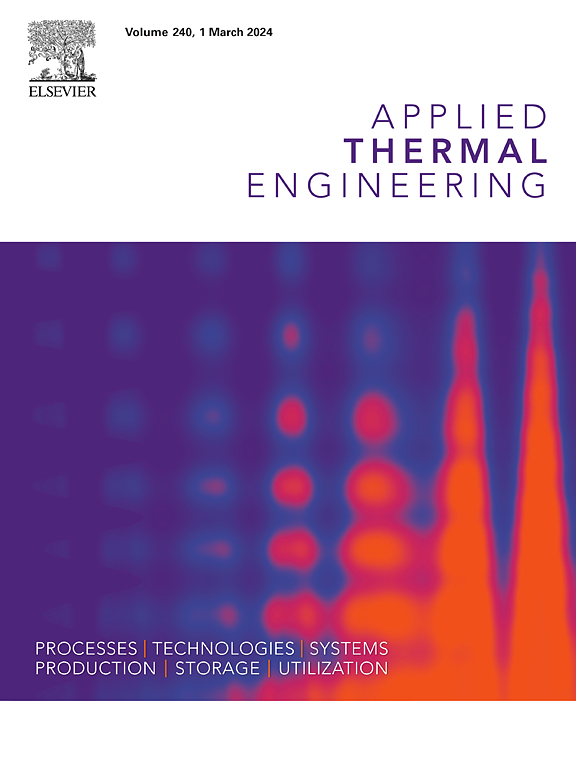利用HCNG发动机废气热提高氢气产量:ASPEN +模拟和机器学习预测
IF 6.9
2区 工程技术
Q2 ENERGY & FUELS
引用次数: 0
摘要
氢气生产在推进运输和发电的清洁能源解决方案方面发挥着关键作用。然而,传统方法因其高能量需求和低效率而面临挑战。本研究探讨了一种将富氢压缩天然气(HCNG)发动机的余热回收与蒸汽甲烷重整(SMR)工艺相结合以提高氢气产量的新策略。该研究分析了在化学计量条件下,在氢气比为20%、废气再循环(EGR)比为24%、发动机负荷为75%、发动机转速为1700转/分的情况下,通过废热利用产氢的情况。利用ASPEN Plus软件对SMR制氢过程进行了模拟,并对换热器和重整器组件的热负荷进行了详细评估。结果表明,在973 K时,将蒸汽甲烷比(S/C)由1提高到6,产氢率由4.01 kg/hr提高到6.85 kg/hr。此外,在规定条件下,从HCNG发动机排气中回收的最大热量达到89.23 kW,而总可用热量为133.12 kW。本研究的另一个关键目标是使用机器学习回归模型预测氢气产量,包括逐步线性回归(SLR),决策树(DT),线性支持向量机(LSVM)和提升树(BT)。这些模型基于不同数据集和输入参数的均方根误差(RMSE)、平均绝对误差(MAE)、决定系数(R2)和计算时间进行评估。其中,单反模型表现出较好的性能,单输入时RMSE为0.514,四输入时RMSE为0.074。SLR显示最小MAE为0.06,最高R2为0.99,证实了较强的预测能力。这些发现有助于将HCNG发动机与SMR和电子控制单元集成在一起,为更高效和可持续的氢气生产提供了一条途径。本文章由计算机程序翻译,如有差异,请以英文原文为准。
Hydrogen production enhancement using exhaust heat from HCNG engine: ASPEN plus simulation and machine learning prediction
Hydrogen production plays a pivotal role in advancing clean energy solutions for transportation and power generation. However, conventional methods face challenges due to their high energy requirements and inefficiencies. This study investigates a novel strategy to improve hydrogen production by integrating exhaust heat recovery from Hydrogen-enriched Compressed Natural Gas (HCNG) engines with the Steam Methane Reforming (SMR) process. The research analyzes hydrogen production by exhaust heat utilization at a hydrogen ratio of 20 %, an Exhaust Gas Recirculation (EGR) ratio of 24 %, an engine load of 75 %, and an engine speed of 1700 rpm under stoichiometric conditions. Hydrogen production via the SMR process is simulated using ASPEN Plus software, with a detailed evaluation of heat exchanger and reformer component heat duties. Results indicate that at 973 K, increasing the steam-to-methane ratio (S/C) from 1 to 6 leads to a rise in the hydrogen production rate from 4.01 kg/hr to 6.85 kg/hr. Additionally, the maximum heat recovered from the HCNG engine exhaust reaches 89.23 kW out of a total available 133.12 kW under the specified conditions. Another key objective of this study is to predict hydrogen production using machine learning regression models, including Stepwise Linear Regression (SLR), Decision Tree (DT), Linear Support Vector Machine (LSVM), and Boosted Tree (BT). The models are evaluated based on Root Mean Square Error (RMSE), Mean Absolute Error (MAE), coefficient of determination (R2), and computational time across different datasets and input parameters. Among the models, SLR demonstrates superior performance, achieving an RMSE of 0.514 with a single input and 0.074 with four inputs. The SLR showed the minimum MAE is 0.06 and the highest R2 value is 0.99, which confirms the strong predictive ability. These findings contribute to the advancement of HCNG engines integrated with SMR and electronic control units, offering a pathway to more efficient and sustainable hydrogen production.
求助全文
通过发布文献求助,成功后即可免费获取论文全文。
去求助
来源期刊

Applied Thermal Engineering
工程技术-工程:机械
CiteScore
11.30
自引率
15.60%
发文量
1474
审稿时长
57 days
期刊介绍:
Applied Thermal Engineering disseminates novel research related to the design, development and demonstration of components, devices, equipment, technologies and systems involving thermal processes for the production, storage, utilization and conservation of energy, with a focus on engineering application.
The journal publishes high-quality and high-impact Original Research Articles, Review Articles, Short Communications and Letters to the Editor on cutting-edge innovations in research, and recent advances or issues of interest to the thermal engineering community.
 求助内容:
求助内容: 应助结果提醒方式:
应助结果提醒方式:


